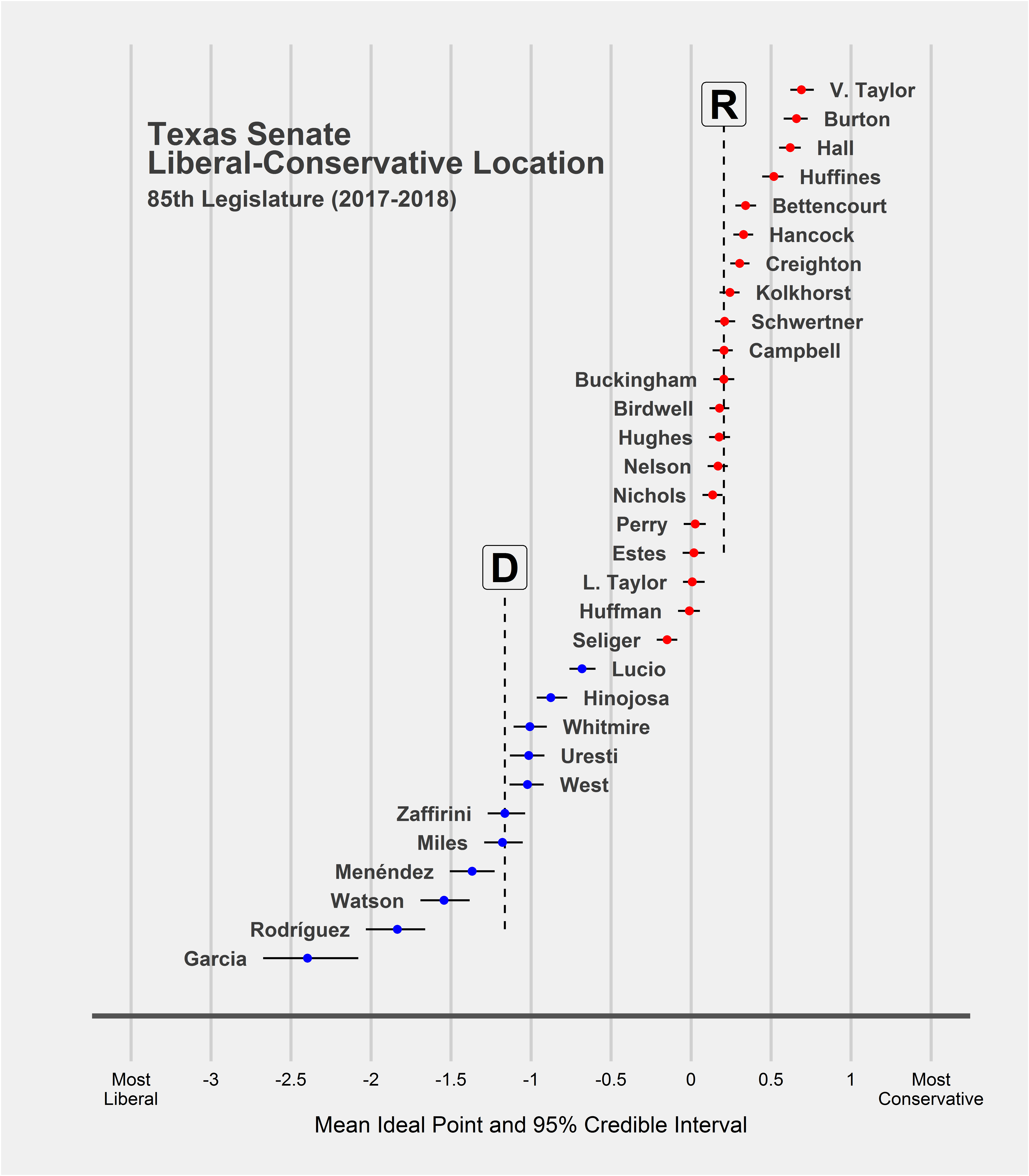The 2017 Texas Senate, from Right to Left

Photo by Todd Wiseman
The recently ended regular session of the Texas Legislature offered a fresh reading of the politics of the members of the Texas Senate — a body that has edged to the right this decade as new senators have been elected.
Political scientists have for decades used roll call votes cast by members of the U.S. Congress to plot them on the Liberal-Conservative dimension along which most legislative politics now takes place. This ranking of the Texas Senate does the same — by drawing on the 1,626 non-lopsided roll call votes taken during the 2017 regular session. As with previous rankings conducted in 2015, 2013 and 2011, this one uses a Bayesian estimation procedure belonging to the family of methodological approaches that represent political science’s gold standard for roll call vote analysis.
Methodology
In the chart, Republicans are indicated by red dots and Democrats by blue ones. The roll call vote analysis provides a mean ideal point for each senator, referred to as the Lib-Con Score, along with the 95 percent credible interval (CI) for that estimate. If two legislators’ CIs overlap, their positions on the ideological spectrum might be statistically equivalent, even if their Lib-Con Scores are different. Also included are vertical dashed black lines, which indicate the location of the median Democratic and Republican senators. (Here’s a table with the 31 senators ranked from most liberal to most conservative.)
As with their House counterparts, it’s important to keep in mind that Republican senators can register Lib-Con Scores that are noticeably lower than those of most of their fellow Republicans while remaining conservative. It simply means their voting records are less conservative than most of their Republican colleagues. In 2017, every Republican senator’s Lib-Con Score is significantly more conservative than that of every Democratic senator; every Democrat’s score is significantly more liberal than every Republican’s.

Republicans
The 20 Republican senators fall into three groups. At the most conservative end of the ideological spectrum is a quartet: Van Taylor of Plano, Konni Burton of Colleyville, Bob Hall of Edgewood and Don Huffines of Dallas. These four senators all have Lib-Con Scores that are significantly more conservative than those of every one of the 16 other Republicans.
At the least conservative end of the Republican ideological spectrum is a quintet: Kel Seliger of Amarillo, Joan Huffman of Houston, Larry Taylor of Friendswood, Craig Estes of Wichita Falls and Charles Perry of Lubbock. All five have Lib-Con Scores that are significantly less conservative than more than two-thirds of their 19 Republican colleagues.
The majority of the Republican delegation’s senators are located between the two above-mentioned groups in a relatively cohesive cluster, with Lib-Con Scores and 95 percent CIs that cross or come close to crossing the party median. This majority group of 11 Republicans is centered on the GOP’s two median senators, Dawn Buckingham of Lakeway and Donna Campbell of New Braunfels.
Democrats
The 11 Democratic senators also fall into three groups. At the liberal end of the ideological spectrum is a trio that includes Sylvia Garcia of Houston, José Rodríguez of El Paso and Kirk Watson of Austin. Garcia’s Lib-Con Score is significantly more liberal than that of every other Democrat.
At the least liberal end of the Democratic ideological spectrum is a duo from the Rio Grande Valley: Eddie Lucio Jr. of Brownsville and Juan “Chuy” Hinojosa of McAllen. Lucio’s Lib-Con Score is significantly more conservative than that of every other Democrat.
As was the case with the Republican delegation, a majority of the Democratic senators lie between these two groups. Near the middle of this majority bloc of six is the Democratic delegation’s median senator — Judith Zaffirini of Laredo. The other five senators in this middle group have Lib-Con Scores and 95 percent CIs that overlap with that of Zaffirini, indicating they are neither significantly more liberal nor conservative than the 30 year senate veteran. This group ranges from José Menéndez of San Antonio and Borris Miles of Houston on Zaffirini’s left to John Whitmire of Houston and Carlos Uresti of San Antonio on her right.
Republican Newcomers and Veterans and the GOP Shift to the Right
Fourteen of the 20 Republican senators were first elected within the past five years. The 2017 session was the first regular session for two Republican senators, the 2015 session the first for eight and the 2013 session the first for four. The 11 most conservative senators in 2017 were all elected between 2012 and 2016. Of the nine least conservative senators, all but three were elected prior to 2012. This highlights a trend previously identified in the large freshman class of 2015, where all but one of the eight Republican senators had a Lib-Con Score that was significantly more conservative than the senator they replaced.
As a result, over the past three electoral cycles, with each replacement of a Republican senator by a co-partisan, the Texas Senate has on average shifted a little more to the right. As a case in point, in 2011, Brian Birdwell of Granbury had the most conservative Lib-Con Score in the Senate. In 2017, Birdwell’s Lib-Con Score is to the left of the Republican Party median, with every senator to his right elected between 2012 and 2016. While it is possible that Birdwell has become notably less conservative over time (that’s a general topic I’ll be looking at later this summer), a more likely explanation is that Birdwell’s ideological location hasn’t changed much between 2011 and 2017, but the senators who have assumed office during the intervening years are on average notably more conservative than their predecessors.
Disclosure: Rice University has been a financial supporter of The Texas Tribune. A complete list of Tribune donors and sponsors can be viewed here.

